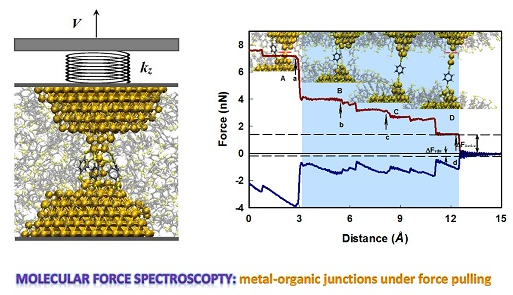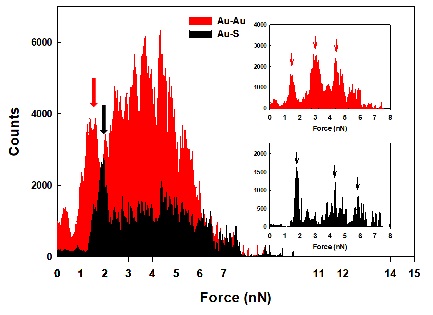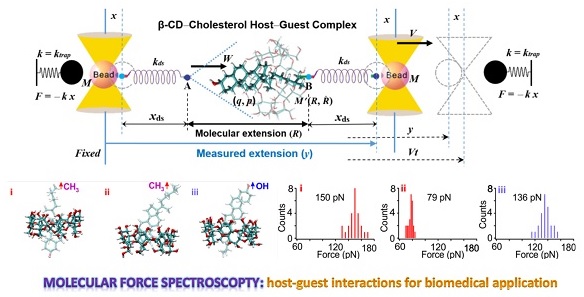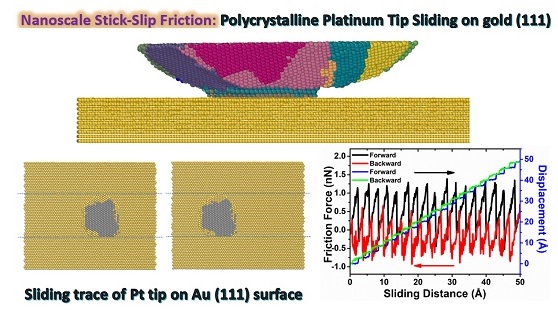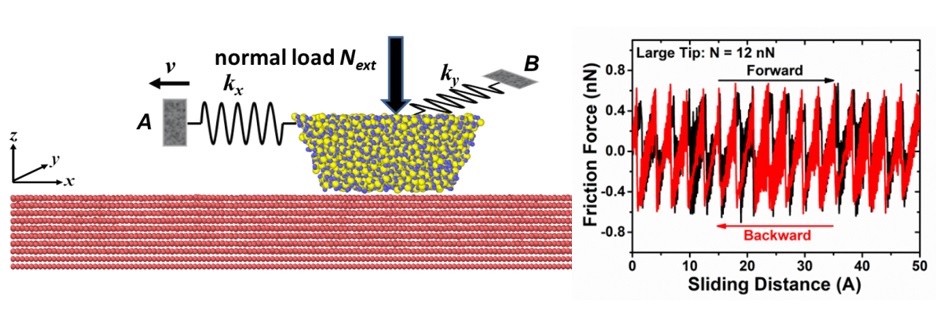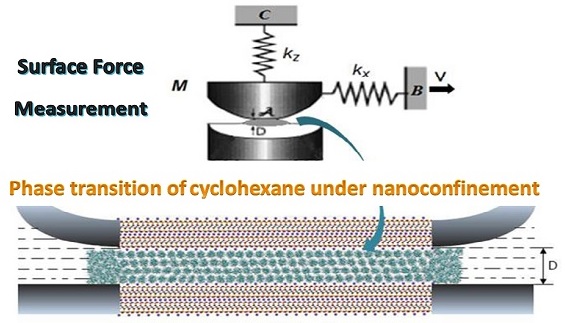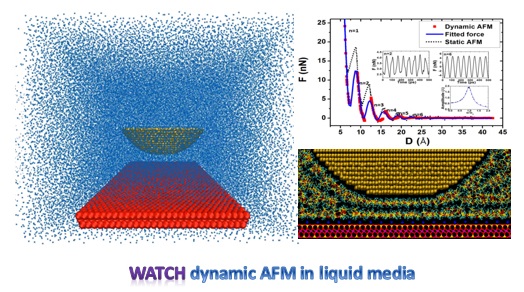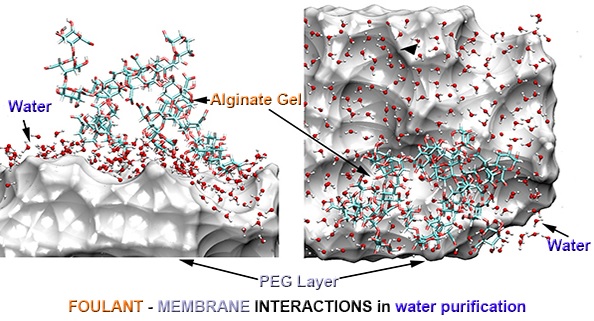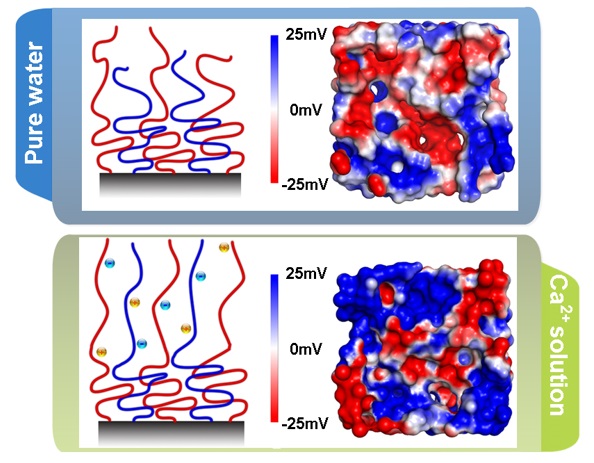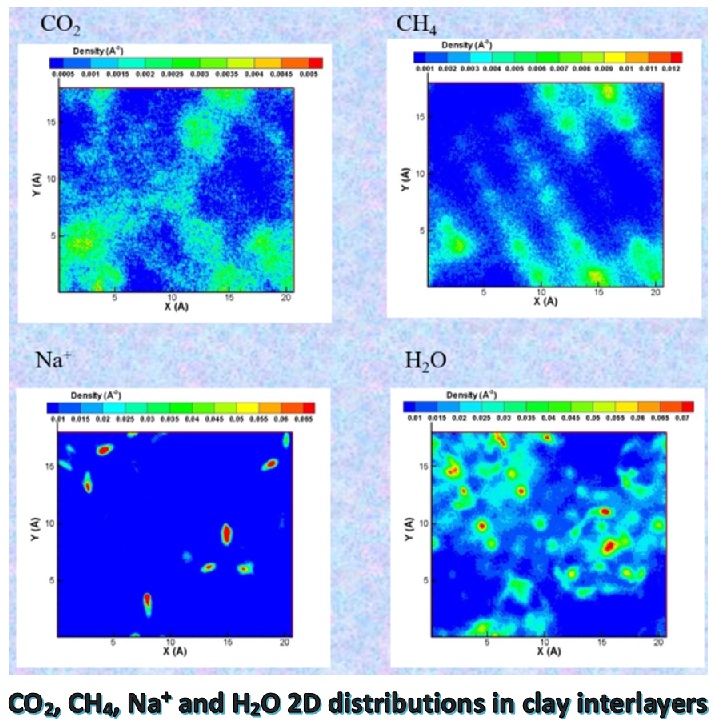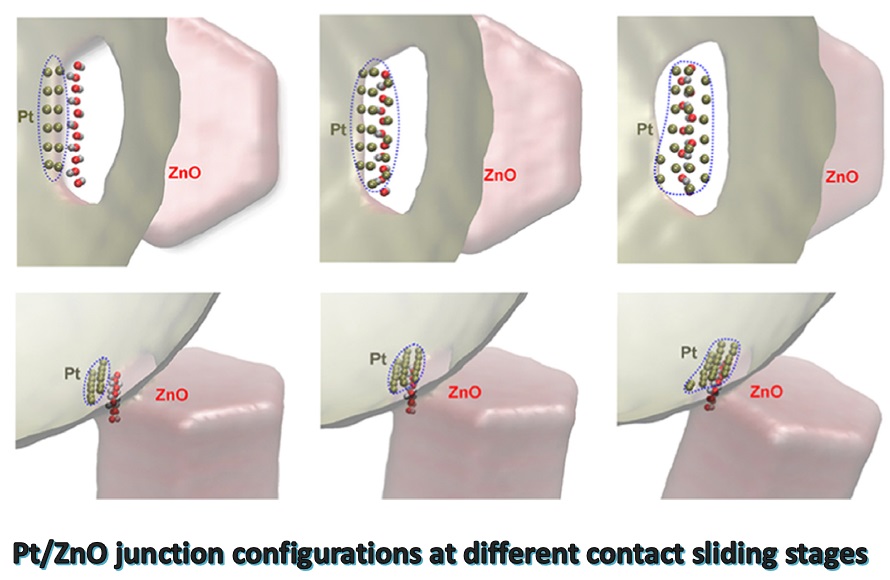
| Research | |
|
|
Bond Breaking in Molecular Force Spectroscopy
Molecular bond breaking or dissociation in a complex chemical/biological environment is a ubiquitous phenomenon under many naturally occurring conditions. Using nonequilibrium force driven to characterize the strength of chemical bonding or physical interactions between different functional groups in a molecular complex has a profound significance in science discoveries, as well as in many engineering and technology applications. The widely used atomic force microscopy (AFM) or scanning probe microscopy (SPM), as well as the laser optical tweezers with pN force resolution, are among many modern techniques to detect and calibrate these tiny molecular forces. However, understanding what is really measured and what is happening to the molecular conformation changes in these slow driven systems under mechanical pulling is a very challenging scientific topic. This is because current molecular dynamics (MD) simulations cannot deal with the “in situ” observations in these molecular force spectroscopies due to the timescale problem. In other words, even using our current fastest High-Performance Computing (HPC) machines, we are still unable to simulate these force spectroscopy experiments at their experimental timescales. To target this science challenge, we are developing new computational algorithms and software tools, from quantum mechanical density functional theory (DFT) calculations and statistical thermodynamics, to machine learning and molecular driven dynamics, to study the intrinsic conformational transition dynamics and mechanisms of molecular interactions. Our goal is to enable both in-silico and in-situ force spectroscopy measurements to proceed at the same experimental timescales to eventually unravel the fundamental kinetics and conformational transition dynamics of molecular complex under realistic chemical/physiological conditions with atomistic resolutions. Selected Publications: 1. Leng, Y. S. and Xiang, Y., "Driven Dynamics of Long-Time Bond-Breaking Events," Langmuir 35, 16961-16968 (2019) |
|
| Computational Simulation and Cyber Software Development for Nanoscale Friction
Friction is a highly convergent topic and exists at the contact between two sliding surfaces. Nanoscale or atomic-scale friction presents a wealth of fundamental science involved in the unlubricated sliding interface between two moving surfaces at nanoscale contacts. The subject is now evolving into a multidisciplinary area that covers physics, chemistry, solid mechanics, materials science, and nanomanufacturing. Understanding friction dynamics, especially the stick-slip motion and energy dissipation in nanoscale contacts, is essential in developing strategies for preventing surface failure and maintaining the critical functioning of numerous nanodevices and nanosystems. This is by far a tremendous effort in the nanotribology science community. Current available computational tools to accelerate MD simulations of nanoscale friction are available in several community software packages, such as the Large-scale Atomic/Molecular Massively Parallel Simulator (LAMMPS) and other computational engines in MD simulation community. We are now developing new advanced friction models and algorithms in the Computational and Data-Enabled Science Project, to understand how stick-slip friction signals are measured in AFM friction experiments in a few benchmark systems, for example, a polycrystalline platinum tip or a silicon amorphous tip sliding on a gold (111) surface. Our goal is to develop a cyberinfrastructure (CI) package to enable users in the friction community to study nanoscale friction properties for a variety of materials at sliding interfaces, therefore, to optimize the design of nanoscale friction machines. Selected Publications: 1. Xu, R. G., Zhang, G. N., Xiang, Y., and Leng, Y. S., "On the Friction Behavior of SiO2 Tip Sliding on a Gold (111) Surface: How an Amorphous SiO2 Tip Produces Regular Stick-Slip Friction?" Langmuir (2023) |
| Phase Behaviors and Shear Properties of Complex Base Fluids under Nanoconfinement
Improving the reliability and efficiency of lubrications for various machines, from automotive engines and wind turbines, to various nanoscale machines, requires a fundamental understanding of the phase behaviors and shear properties of complex base fluids under nanoconfinement. As more stringent industrial and environmental demands for the reduction of fuel consumption and pollution, there is an aggressive push to develop multifunctional lubricants and lubricant additives, and at the same time, to decrease the complexity of lubricant formulations. From a materials standpoint, hydrocarbon fluids confined between two surfaces to nanometers thickness is of fundamental interest in surface and interfacial science. In the past decades, many surface force experiments found that the normal force - distance profiles measured always exhibited force oscillations within a distance of 7-8 molecular diameters of the liquid molecules. However, the nature of this oscillatory force and layering transition is still not quite understood. Moreover, shearing of the nanoconfined films also showed stick-slip friction, a typical solid-like material response. We recently developed a liquid-vapor molecular dynamics (LVMD) simulation method to study these interesting phenomena. Our findings showed that simple hydrocarbon liquids such as cyclohexane (a spherical-like molecule) exhibits liquidlike-to-solidlike phase transition under normal compression. Under shear, boundary slips at solid–lubricant interfaces happen, while the solidified structure of the lubricant film is well maintained during repeated stick–slip friction cycles. Our current interest in this field is to understand the friction behaviors of hybrid star lubricants containing silicate-based core structures. Typical fluids of this kind include the Octamethylcyclotetrasiloxane (OMCTS) and its derivatives. Developing more advanced molecular models based on DFT calculations to build more realistic force field parameters for such hybrid organic fluids are under way. Selected Publications: 1. Xu, R. G. and Leng, Y. S., "Squeezing and Stick-slip Friction Behaviors of Lubricants in Boundary Lubrication," Proceedings of the National Academy of Sciences 115, 6560-6565 (2018) |
|
Hydration Force, Hydrophobic Interactions, and Membrane Antifouling in Aqueous Systems
The mechanical properties of aqueous films under confinement have many implications in materials science and engineering. Many biological processes, such as interactions between cell membranes, water transport through ion channels in crowded intracellular environment, protein folding and bio-lubrication, all involve water-hydrophobic and water-hydrophilic group interactions in a complex chemical/biological environment. In many cases, hydrated metal ions are present that play a significant role. These fundamental problems are particularly relevant to membrane antifouling, an important technology application in many engineering application settings. We applied LVMD simulation to study the repulsive hydration force mechanism in electrolyte solutions between two charged surfaces and hydrophobic collapse between two hydrophobic plates immersed in water. We showed that the load bearing capacity of the dense electrolyte is largely attributed to the hard hydration shells of metal ions under nanoconfinement. To understand membrane-foulant interactions, we also applied LVMD simulation to calibrate binding characteristics between polyamide membrane and alginate molecules (one of the typical foulants in natural environment). Our studies showed that hydrated metal ions play a central role in building ionic bridges to promote membrane fouling. However, when the membrane surface is modified by grafting antifouling materials such as polyethylene glycol (PEG) or Polyzwitterion coatings, excellent antifouling properties of the membrane surfaces could be achieved. Selected Publications: 1. Xiang, Y., Xu, R. G., and Leng, Y. S., "How Alginate Monomers Contribute to Organic Fouling on Polyamide Membrane Surfaces?" J. Membrane Science 643, 120078 (2022)2. Xiang, Y., Xu, R. G., and Leng, Y. S., "Molecular Understanding of Ion Effect on Polyzwitterion Conformation in an Aqueous Environment," Langmuir 36, 7648-7657 (2020) 3. Lei, Y. J. and Leng, Y. S., "Hydrophobic Drying and Hysteresis at Different Length Scales by Molecular Dynamics Simulations," Langmuir 28, 3152-3158 (2012) 4. Leng, Y. S., "Hydration Force and Dynamic Squeeze out of Hydration Water under Subnanometer Confinement," Journal of Physics: Condensed Matter 20, 354017(2008) 5. Leng, Y. S., "Hydration Force between Mica Surfaces in Aqueous KCl Electrolyte Solution," Langmuir 28, 5339-5349 (2012) |
|
Clay Mineral – Geological Complex Fluid Interactions in Carbon Sequestration
Carbon dioxide (CO2) emission from fossil fuel combustion is a major contributor to climate change. CO2 capture and sequestration in onshore geological subsurface or in offshore sediments is considered to be a promising option to counteract the accumulation of CO2 in the atmosphere and mitigate climate change. Fundamentally, the structure and thermodynamic properties of multicomponent, complex geological fluids, including water, CO2, and different hydrocarbon species in various clay media, are relevant to many geochemical processes in carbon sequestration and carbon mineralization (But ironically, the topic is also related to enhanced natural gas recovery). Molecular understanding of these systems, especially in clay interlayers, could provide crucial knowledge of clay-fluid interactions in the subsurface, gas adsorption/desorption processes, and macroscopic modeling for chemical process design and control. We use thermodynamics theory, grand canonical Monte Carlo sampling and MD simulations to investigate supercritical carbon dioxide – aqueous hydrocarbon fluid interactions in clay interlayers under typical CO2 geological sequestration conditions. These fundamental studies will advance our predictive modeling and controlling of surface reactions, carbon sequestration, and also more efficient energy production. Selected Publications: 1. Rao, Q. and Leng, Y. S., "Molecular Understanding of CO2 and H2O in a Montmorillonite Clay Interlayer under CO2 Geological Sequestration Conditions," J. Phys. Chem. C 120, 2642-2654 (2016)2. Rao, Q., Xiang, Y., and Leng, Y. S., "Molecular simulations on the structure and dynamics of water-methane fluids between Na-Montmorillonite clay surfaces at elevated temperature and pressure," J. Phys. Chem. C 117, 14061-14069 (2013) |
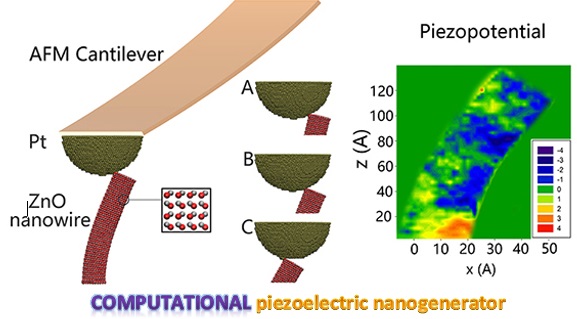
|
Computational Emerging Metal-Semiconductor Junctions and 2D Elemental Semiconductor Materials under Mechanical Strain Modulation
Developments of high-power, ZnO-based piezoelectric nanogenerators are seen in the last decade. Numerous novel properties of two-dimensional (2D) elemental semiconductor materials, such as tellurene – an atomically thin tellurium (2D Te), are found recently. In particular, 2D tellurene possesses a robust and flip-invariant, out-of-plane piezoelectricity under mechanical strains (courtesy of Wenzhuo Wu, Purdue University), providing a novel platform for investigating the intriguing piezo-electronic coupling between mechanical strain and a variety of physical properties. We use computational simulations based on density functional theory (DFT) and MD simulations to investigate different phases and phase transformations of 2D tellurene under mechanical strain modulation. We also analyze the structural properties of metal/ZnO junction and its piezoelectric and mechanical properties under mechanical bending in a sliding-bending piezoelectric nanogenerator. These computational studies establish a foundation to collaborate with experimentalists to develop novel piezo-electronic devices and systems. Selected Publications: 1. Xiang, Y., Gao, S. J., Xu, R. G., Wu, W. Z., and Leng, Y. S.,"Phase Transition in Two-Dimensional Tellurene under Mechanical Strain Modulation," Nano Energy 58, 202-210 (2019)2. Jnawali, G., Xiang, Y., Linser, S., Shojaei, I., Wang, R., Qiu, G., Lian, C., Wong, B. M., Wu, W. Z., Ye, P. D., Leng, Y. S., Jackson, H. E., and Smith, L. M.,"Ultrafast Photoinduced Band Splitting and Carrier Dynamics in Chiral Tellurium Nanosheets," Nature Communications 11, 3991 (2020) 3. Tan, D., Xiang, Y., Leng, Y. G., and Leng, Y. S.,"On the Metal/ZnO Contacts in a Sliding-Bending Piezoelectric Nanogenerator," Nano Energy 50, 291-297 (2018) |
